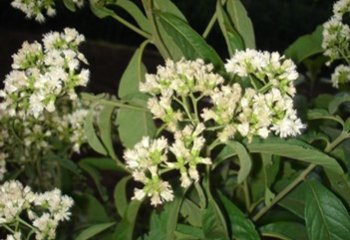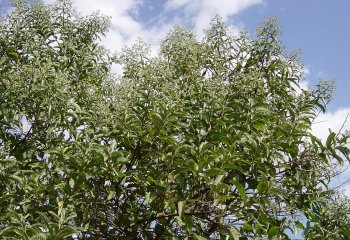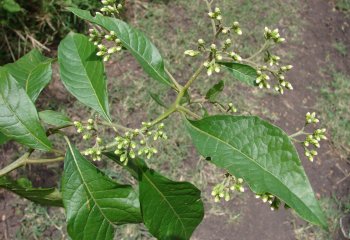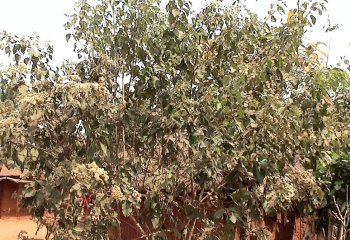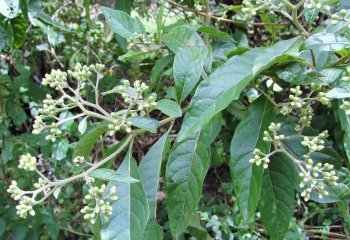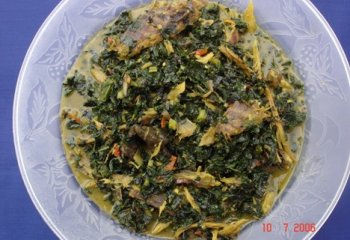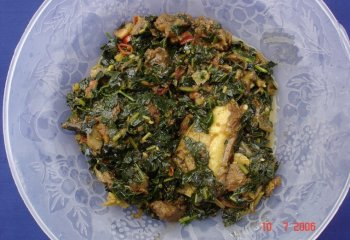Geographical Distribution in Africa
Vernonia amygdalina is native to tropical Africa, Yemen and eastern Brazil. In Africa, it occurs from West Africa to East Africa and south to N.E. South Africa. It has been introduced in other tropical regions (Ucheck Fomum, F., 2004).
Read more
Gabon: Ndoki
Ghana: Jankpantire, Odwono
Kenya: Olulusia, Cheburiandet
Nigeria: Ewuro, Etidod, Onugbu, Chukwu
Rwanda: Umubilizi
Swaziland: Linyatselo
Tanzania: Omumbilizi
Togo: Souwaka
Uganda: Omubilizi, Labwori, Maluluza
Zimbabwe: Musikavakadzi
Local names (Detailed)
Angola: (Mu) Lulu (Kimbundu) (Bossard, E., 1996); Malulu (Kikongo) (Lautenschläger et al., 2018)
Benin: Alomagbo, Amanvivè (Fon, Gon) (Mahi) (Agbankpe et al., 2015), Aloma (Watchi) (Adjanohoun & Technique, 1989)
Burkina Faso: Kosafne (Jula) (Belem et al., 1996)
Burundi: Umupfumya, Umubirizi (Kirundi) (Baerts & Lehmann, 1989)
Cameroon: Ndolé, Ndolè Sucré (Local French) (Yemeda et al., 2016), Ated nkol, Suwaaka (Yeap et al., 2010)
Central Africa: Mubilisi (Kirega), Mungangandu (Libinza), Oka, Onka, Ngbendele, Okan (Ngwaka), Ndolo (Kuala), Koolo (Langbasi), Lingbengbele (Ngombe) (Mbuta et al., 2012)
Congo: Munkankali (Téké), Mundundindundi (Yombé), Matoulou (Téké) (Adjanohoun et al., 1988), Umubilizi (Kinyarwanda), Omwirizi (Hunde), Mulirizi (Mashi), Mubiritsi (Nyanga) (Ayobangira et al., 2000); Omuviriri (Kinande), Kilulukudja (Swahili) (Kasonia et al., 1993); Nkulu-Nkulu, Mundudi Ndudi, Mukari Kari (Kikongo), Mukadi Kadi (Kiyanzi), Mindudi Mintela (Kiyombe) (Kibungu Kembelo, A. O., 2004); Mundurinduri (Kimpouni et al., 2018)
DRC: Malulu (Kikongo)
Ethiopia: Eebicha (Afaan Oromoo), Ebicha (Bussmann et al., 2011); Garaa (Konta) (Bekalo et al., 2009), Girawa (Amharic) (Chekole et al., 2015); Grawa / Merari Kelewa (Amharic) (Chekole et al., 2015); He’echo (Doffana 2017); Gera (Araf) (Kidane et al., 2014)
Gabon: Ndoki (Akendengué & Louis, 1994)
Ghana: Jankpantire (Lobi) (Asase et al., 2005) Awonoo (Asase & Mensah, 2009); Odwono (Asante-Twi) (Agyare et al., 2009) Shawka (Adangbe) (Asase et al., 2010); Awonwono (Twi Dialect) (Appiah et al., 2018); Awonwono (Komlaga et al., 2015)
Kenya: Omororia (Kisii), Musuritsa (Luhya), Omulusya (Luhya), Kumwilulusia, Kumululusia (Bukusu), Olusia (Luo), Olulusia (Luo), Cheburiandet (Nandi), Cheburiundet (Sabaot) (Orwa et al., 2009, Yeap et al., 2010
Nigeria: Ewuro (Yoruba) (Adetutu et al., 2011), Etidod (Ibibio) (Ajibesin et al., 2008) Onugbu/Olubu (Igbo), Shiwaka/Chukwu Aka (Hausa) (Aiyeloja & Bello, 2006) Ebeoyara (Edo) (Attah et al., 2012)
Rwanda: Umubilizi, Umuyobora (Kinyarwanda) (Desouter, 1991).
Swaziland: LiNyatselo (Yeap et al., 2010)
Tanzania: Mtugutu (Zigua) (Chhabra et al., 1989); Msembereghu; Mtembereghu (Batemi) (Johns et al., 2008); Omumbilizi (Haya) (Kisangau et al., 2007)
Togo: Aluma / Gbondutsi (Agbodeka et al., 2016); Aloma (Holaly et al., 2015); Souwaka (Tem) (Karou et al., 2011)
Uganda: Omubilizi (Ankole) (Desouter, S., 1991); Labwori (Acholi, Ouganda), Kibiriri (Rukonjo), Omubirizi (Runyankole, KI, Runyaruguru), Maluluza (Luganda) (Mugisha & Origa, 2007); Ekivilis (Rutooro), Omuvilisi (Rukiga) (Lacroix et al., 2011)
Zimbabwe: Musikavakadzi (Shona) (Kambizi & Afolayan, 2001), Rurimirwemombe (Shona) (Hyde et al. 2018).
Introduction
Vernonia amygdalina, commonly known as bitter leaf (bitterleaf) belongs to the genus Vernonia in the family Asterace
ae (sunflower family). The genus Vernonia is vast, comprising over 1000 species, among them, more than 300 species in Africa, with approximately one-third of these in Madagascar.
Four related woody species used as vegetable are known by the name bitter leaf: The common bitter leaf (Vernonia amygdalina), the sweet bitter leaf (V. hymenolepis), star-flowered bitter leaf (V. colorata) and country bitter leaf (V. thomsoniana). A fifth vegetable species, Vernonia cinerea or little ironweed is an annual commonly found in crop fields. V. amygdalina and V. hymenolepis are mainly wild but are often cultivated or preserved in cropland in West Africa. The similar looking V. colorata is less frequently cultivated and is generally found in drier areas of Africa. It is frequently consumed in the drier parts of West and Central Africa. V. thomsoniana is more commonly found in the wild particularly on highlands and is the bitterest of the five species.
Species within the genus Vernonia are very variable and differences may not be obvious especially between V. colorata and V. amygdalina. V. thomsoniana has smaller leaves than the cultivated ones.
Vernonia amygdalina holds great culinary and medicinal significance in Africa. Despite its bitter taste, the leaves are widely used in traditional African cuisine as a vegetable and for flavoring soups and stews. The bitterness is often reduced by mixing with other vegetables like the waterleaf (Talinum triangulare). Varieties that are less bitter can be found, but are still not common. V. amygdalina is commonly found in Nigeria, Cameroon, Gabon and Congo (Democratic Republic) and to a lesser extent in their neighboring states. The Luhya in western Kenya use V. amygdalina as a vegetable, but do not cultivate it. This bitterleaf species can also be found in South-East Asia where it is similarly grown as a vegetable. Bitter leaf is a popular vegetable in West Africa. In Cameroon the species grows spontaneously all over the country.
Apart from its culinary use, Bitter Leaf has a long history of use in traditional medicine. It is believed to possess various medicinal properties, the leaves, roots, and stem, are used to treat ailments such as malaria, stomachaches, and fevers. Several countries in Africa, including Nigeria, Ghana, and Cameroon, are major producers and consumers of Bitter Leaf due to its popularity in local cuisines and traditional medicine. In the global markets, herbal medicine companies and health food stores source Bitter Leaf extracts and supplements from both local African producers and international suppliers (Ucheck Fomum, F., 2004).
Bekele-Tesemma et al, 2007
Species accounts
Vernonia amygdalina is a single-stemmed shrub to 3 m, sometimes a tree to 10 m. The much branched; stem may be up to 40 cm in diameter. Bark: Pale grey, rather rough, flaking later, branches brittle. Leaves: Ovate, up to 20 x 5 cm, tapering at both ends, dark green above, soft pale hairs below, edge may be widely toothed. Flowers: White-green, each only 6 mm across, in dense branching flattened heads to 30 cm across, sweet scented in the evening. Fruit: Tiny seeds with stiff white hairs.
V. amygdalina is easily mistaken with V. colorata in West and Central Africa. The two species are used in a similarly manner. V. amygdalina has leaves with irregular edges, dented with hairy fruits. It grows spontaneously in secondary forest. V. colorata on the contrary has leaves with regular edges with glabrous fruits. It grows in dry derived savannahs. The leaves of V. amygdalina are sometimes collected from the wild but most people prefer leaves from cultivated plants which are generally less bitter. (Stivels, 1990, Ucheck Fomum, 2004).
© Bekele-Tesemma et al, 2007
Ecological conditions
Vernonia amygdalina occurs naturally along rivers and lakes, in forest margins, woodland and grassland, up to 2000 m. It often occurs in disturbed localities such as abandoned farmland, and can be found growing spontaneously in secondary forest. It requires full sunlight in cultivation. Flowering is induced by short days. It prefers a humid environment although it is fairly drought tolerant. It can be found on all soil types, but performs best in humus-rich soils.
The species has been observed to be eaten by goats in Central Zone of Delta State, Nigeria. However, in general, it has been found that Vernonia amygdalina have an astringent taste, which affects its intake (Bonsi et al., 1995a). A mixture of Vernonia and molasses has been tried in order to make bitterleaf more palatable by animals, but 6.6 % of DM intake had to be added to improve the intake of Vernonia. During the dry period, dairy farmers in southern Ethiopia feed animals with boiled Vernonia, since the boiling decreases the content of secondary plant compounds and makes the feed more palatable. Vernonia amygdalina has also been fed to broilers, where it was able to replace 300 g kg-1 of maize-based diet without affecting feed intake, body weight gain and feed efficiency (Teguia et al., 1993 cited by Bonsi et al., 1995a).
©Bekele-Tesemma et al, 2007
Related species
1. Vernonia hymenolepis can be found wild in mountainous areas in Cameroon, Uganda, Kenya, Tanzania and Ethiopia and is frequently cultivated in Cameroon where it is referred to as sweet bitterleaf. It is also called bayangi bitterleaf because of its popularity with the Bayangi people in the Manyu division of South-West Cameroon. Sweet bitterleaf is grown as an annual crop, which reaches a height of about 75 cm when grown as a kitchen-garden crop or in mixed cropping systems, whereas in the wild it can be either annual or perennial depending on the availability of moisture in the soil. In some places near streams, wild shrubs of 3 m high can be observed which are probably at least 2 or 3 years old. V. hymenolepsis is by far the least tolerant to drought. It is therefore often found in marshy areas or at high altitudes and its cultivation during the dry season requires frequent irrigation.
2. Vernonia colorata
This is a shrub or small tree. The leaves are oval or more frequently elongated, with distinctly undulate margins. The upper surface is harshly hairy, the undersurface covered in dense woolly hairs, obscuring the net-veining. The flowerheads are star-shaped, forming large terminal clusters, mauve when young but soon turning white. Of the four frequently consumed Vernonia species in West Africa, V. colorata is most tolerant to drought (Hyde et al, 2018).
©Maundu, 2009
3. V. thomsoniana is an erect slender, sparingly-branched shrub up to 3(5) m. tall. Stems may be one to several with the upper stem and branches finely ribbed and densely hairy. Leaves are 10 x 5 cm. or larger. The lower surface is soft-hairy. The species is found from sub-montane forest margins and grassland to high rainfall mixed deciduous woodland and grassland throughout tropical Africa from Guinea and the Sudan southwards to Angola and Mozambique at medium altitudes.
4. Vernonia cinerea is an erect, branched or unbranched herb up to 1.5 m high, usually 30-100 cm. Stem with longitudinal lines, hairy. Leaves: Broadly ovate, slightly hairy, margin wavy or toothed, base flat, narrowed or rounded. Flowers: Purple or white, borne on a terminal branched inflorescence.
The species is widespread in Africa. It is mainly found in wet areas, in grassland, roadsides, disturbed areas and cultivated land as a weed, often under trees. Commonest during wet seasons in hot low areas, 0-1,700 m. The leaves are used as vegetables among the Mijikenda groups of Kenya. Leaves are often cooked with other vegetables as by themselves, they have a strong odour. Common combinations are Launaea cornuta (mchunga), amaranths and cowpea leaves. It can be grown easily from seed. (Maundu et al., 1999).
Agronomic aspects
Propagation is possible by seed, but most farmers use stem cuttings selected on the basis of attributes such as degree of bitterness, leaf size and growth characteristics. In home gardens more than one type is often grown because young people prefer the less bitter types and elderly people the more bitter ones. Cuttings grow faster than seedlings. Seed may be collected from dry flower heads. Seedlings are grown under shades. Seeds are broadcasted or sown in lines spaced at 15-20cm apart. After 7 days seedlings emerge. Overcrowding will cause rotting of seedlings. When the weather is dried, watering is to be done at least once a day. Before transplanting the seedlings, leaves are tasted for their bitterness using the tongue. The seedlings are transplanted at 6 weeks old. In mixed cropping systems, seedlings are spaced 75 x 75 cm, while they are spaced at about 20 x 20 cm in monocropping. A closer spacing will reduce the vigour due to etiolation (being thin and tall) and competition for nutrients and water. In some home gardens people plant bitterleaf amongst other crops or as a hedge or live fence; in commercial fields it is planted in rows
Cultivation practices
V. amygadalina is generally multiplied by planting shoots in to the soil. Mature and young stem cuttings are used for planting. The cuttings are planted at 450 angle to foster the growth of shoots. Cuttings are selected from varieties known for their attributes. Young leaves that emerge after about three weeks are in a high demand in the market especially during drought periods.
Husbandry
Weeding, mulching and the application of organic manure in the nursery stage contribute to healthy and rapid growth of seedlings and cuttings. During the dry season bitterleaf is scarce and thus expensive at the markets and therefore irrigation is profitable. Old branches should be pruned back to a low level to stimulate the production of larger, succulent and abundant foliage. This is best done before the arrival of the rains. Some farmers deliberately prune their bushes back at the end of the rainy season and make sure that the plants receive adequate water. The young light-green sprouts with large leaves that emerge after about 3 weeks are very valuable at the market, since at that time most other leaves have turned grayish in color, are much smaller and distinctly coarser and bitter. Young plants are more productive than older ones and commercial farmers prefer to plant a new crop at the beginning of every new season or after the second year. They do not remove their old crop until they have been able to harvest the first regrowth at the start of the season because this commands a premium price.
Harvesting and post-harvest practices
Harvesting
The first harvest takes place at about 4 weeks after transplanting. Plants are ratooned at 5-10 cm above ground, when the plants are about 40-50 cm in height. This operation will enable the lateral shoots to grow and extend harvesting for 2 to 3 months. During the rainy season, harvesting takes place by cutting the leafy shoots, allowing new side shoots to develop, which can be harvested a few weeks later. Stems of various lengths are cut in the afternoon and these are sorted and tied into bundles of equal length. The bundles are kept overnight, placed upright in a basin of water and sometimes covered with jute bags to avoid desiccation. The bundles themselves are tied together into bigger bundles before they are carried to the market. During the dry periods people pick only the leaves and leave the shoots intact. Young pale green sprouts with large leaves grown under irrigation during the dry periods fetch high prices in the market, because by this time most leaves of other plants are small and very bitter.
After each harvest, urea is applied to help growth of new shoots. Contact of urea and leaves should be avoided to prevent fertilizer burn. Stems are tied in bundles whose size varies with the season. The bundle can be about 1kg in rainy season but reduces to about ½ kg during the drought period.
Post-harvest practices
Stems of various lengths are cut in the afternoon and tied into bundles. These bundles are kept overnight, placed upright in a basin of water. Alternatively, several other bundles are tied together and sprinkled with some water ready for market. Sometimes bundles are covered with jute bags to avoid desiccation.
Leaves may be shredded and pounded in a mortar. During pounding foam develops. This foam and bitterness is removed by repeatedly rinsing the leaves with water between poundings. Leaves may be shredded and boiled first. The pounded leaves are rinsed until the water that drains off is no longer green. Alternatively, the leaves are pressed into fist-sized balls before they are marketed. People have become careful when buying processed bitterleaf because some unscrupulous traders use other plants to increase the volume. Office workers in the main cities no longer have the time to prepare bitterleaf themselves and have become accustomed to a ready-made product offered at the local markets. A more bitter product is obtained by stopping the formation of foam during pounding by adding palm oil.
In urban areas, consumers are accustomed to buying ready-made products to cook their meals. Thus there is high demand for these processed products (Schippers, 2000).
Nutritional value and recipes
The bitter taste of Vernonia amygdalina is due to anti-nutritional factors such as alkaloids, saponins, tannins and glycosides (Buttler and Bailey, 1973; Ologunde et al., 1992 cited by Bonsi et al. 1995a; Anonymous, 1999). The leaves are rich in protein, fibre, calcium, iron, magnesium, potassium, zinc, vitamin A, riboflavin, Vit B6 and folate.
© Bekele-Tesemma et al, 2007
Food Name |
Vernonia (bitter leaves), fresh. raw |
Vernonia (bitter leaves), fresh. boiled* (as part of a recipe) |
Vernonia (bitter leaves), fresh. boiled* (without salt drained). |
Recommended daily allowance (approx.) for adultsa |
Edible conversion factor |
0.8 |
0.79 |
0.8 |
|
Energy (kJ) |
273 |
290 |
279 |
9623 |
Energy (kcal) |
65 |
69 |
66 |
2300 |
Water (g) |
80.3 |
79 |
79.9 |
2000-3000c |
Protein (g) |
5 |
5.3 |
5.1 |
50 |
Fat (g) |
0.9 |
1 |
0.9 |
<30 (male), <20 (female)b |
Carbohydrate available (g) |
6.7 |
7.1 |
6.8 |
225 -325g |
Fibre (g) |
5.1 |
5.4 |
5.2 |
30d |
Ash (g) |
2 |
2.2 |
2.1 |
|
Mineral composition |
|
|
|
|
Ca (mg) |
170 |
181 |
165 |
800 |
Fe (mg) |
2.1 |
2.2 |
1.6 |
14 |
Mg (mg) |
95 |
101 |
58 |
300 |
P (mg) |
75 |
80 |
69 |
800 |
K (mg) |
594 |
632 |
303 |
4,700f |
Na (mg) |
11 |
12 |
9 |
<2300e |
Zn (mg) |
1.88 |
2 |
1.44 |
15 |
Se (mcg) |
|
|
60 |
|
Cu (mg) |
0.75 |
0.8 |
0.73 |
0.9 |
Bioactive compound composition |
|
|
|
|
Vit A RAE (mcg) |
484 |
464 |
445 |
800 |
Vit A RE (mcg) |
242 |
232 |
222 |
800 |
Retinol (mcg) |
0 |
0 |
0 |
1000 |
b-carotene equivalent (mcg) |
2,900 |
2,780 |
2,670 |
600 – 1500g |
VIT D (mcg) |
0 |
0 |
0 |
5 – 15* |
VIT E (mg) |
0.42 |
0.45 |
0.43 |
9 |
Thiamin (mg) |
0.09 |
0.09 |
0.06 |
1.4 |
Riboflavin (mg) |
0.2 |
0.2 |
0.13 |
1.6 |
Niacin (mg) |
0.6 |
0.6 |
0.4 |
18 |
Vit B6 (mg) |
0.24 |
0.23 |
0.16 |
1.3h |
Folate (mcg) |
57 |
42 |
29 |
400f |
Vit B12 (mg) |
0 |
0 |
0 |
3 |
Vit C (mg) |
29 |
18 |
12 |
60 |
Source (Nutrient data): West African food composition table (Stadlmayr, 2012)
$ Draining the water several times leaches away water soluble nutrients significantly.
a Lewis, J. 2019. Codex nutrient reference values. Rome. FAO and WHO
b NHS (refers to saturated fat)
c https://www.hsph.harvard.edu/nutritionsource/water/
d British Heart Foundation
e FDA
f NIH
g Mayo Clinic
h For pregnancy and lactation, the amount increases to 1.9 mg and 2.0 mg, respectively
Complimentary recipes
In Cameroon, bitterleaf is processed in three main ways to reduce the bitterness. Firstly, the leaves are shredded from the stems, sliced into tiny slices and then subjected to squishing and rinsing several times with cold water. Alternatively, the sliced leaves are pounded in a mortar before squishing and rinsing for those who do not want to use soda (limestone). Secondly, it can be blanched for 5-10 minutes in hot water in which potash has been added before squishing and rinsing. In all cases, the product is rinsed several times to get out the foaming greenish liquid, which is the bitter part of it. The squishing and rinsing continues until the foaming stops and the liquid from the vegetable is almost clear. Thirdly, whole leaves that are not sliced or chopped are blanched in hot water and used mostly in porridges. Seasonings of choice are used. These include seasoning cubes, green leafy species (like ground celery, basil, leeks and parsley) and pepper. Depending on the occasion ground egusi (seeds of the members of Cucurbitaceae e.g. pumpkin and gourd seeds), smoked fish or meat is added. This is served with fufu (starchy component of a meal made from flour derived from corn, yams, plantains or cassava), boiled plantains, yams, cocoyams, taro and potatoes.
1. Nndole soup
Ingredients
1 kg beef
200 g stockfish (cut into small pieces)
1/3 cup dried shrimps
1 cup fresh peanuts (dehulled)
1 small onion
2 medium fresh round red pepper
2 cloves garlic
500 g bunch fresh bitter leaf (Vernonia amygdalina)
Salt
(Enough for 5-6 persons)
Method
• Clean, cut up and wash meat, season with some salt and half onion, put to boil with about 3 cups water, half way through boiling (15-20 minutes) wash stockfish and add to boiling meat, cook both until tender adding more water if necessary, remove from pot and set aside, save the meat stock
• Wash bitter leaves, blanch peanuts, remove from heat and peel off skin, grind and set aside
• Grind dried shrimps, then grind together pepper, garlic and the rest of the onion
• Heat oil moderately in a pot, add ground peanuts, and the ground pepper mixture, fry for 5-7 minutes stirring constantly
• Add stock from the boiled beef and stockfish making it up to 4 cups with water, add boiled meat and stockfish, ground shrimps and washed bitter leaves, salt to taste and stir very well.
• Allow to cook under low heat fro 15-20 minutes stirring occasionally
• Serve hot nndole with boiled yam, plantain, rice or cassava.
Source: Foods of West Africa-Origin and use by Francisca Smith.
2. Ndole (Ndunekun) and groundnut paste)
Ingredients
150 g washed bitterleaf
2 tablespoonfuls groundnut flour
4-6 medium size smoked fish (or 1 kg beef)
2 tablespoonfuls of cooking fat
1 teaspoonful Salt
3 seasoning cubes or 1 tablespoonful of curry powder
1 chili pepper
1 tablespoonfuls of soya
60 g onions
1 tablespoonful ginger
1 tablespoonful garlic
100 g crayfish
Green leafy species (stalks of celery, leeks and parsley), optional
Preparation
For this dish, the preferred method of washing the bitter leaf is by using limestone Wash dried grains of peeled groundnuts and soak in water for about 30 minutes
Boil groundnuts for 5 minutes and grind into paste and mix well
Chop the meat into cubes and boil till tender
Remove skin and shred the fish and wash (soak fish to remove skin if tough)
Wash bitter leaf using limestone as above
Blend the garlic, ginger, hot pepper and crayfish
Add the oil to a separate saucepan, and heat it
Add chopped onion and shredded fish and fry till it begins to turn golden brown, and then add the groundnut paste bit-by-bit stirring all the time to ensure it does not burn. Allow to simmer over low heat for 15 minutes
Add the ground ingredients, the meat, salt and seasoning cubes, stir and cook for 10 minutes
Add the bitter leaf into the mixture while stirring, also add ground leafy species at this stage, and allow cooking for 5 minutes
Serve warm with yam, plantain, fufu or other preferred starchy staple.
Remarks:
Mature leaves are preferred as young ones are too soft. However, the mid-vein is removed to help reduce the bitterness and toughness.
Too much of either groundnut or soybean paste will dilute the recipe causing it to appear as a soup.
For this recipe soybean can replace groundnut paste in this popular dish called ‘ndole’. To prepare the soybeans, boil same number of cups of soybeans till they are cooked, i.e. soft when pressed between the fingers. When cooked remove the skin, and grind in blender. The rest of the steps as described for groundnut paste.
The recipe could be quite bitter.
Source: Poubom CF, Ngundam, Mboussi a Messia and Simon Zok in: A Cookbook of African Leafy Vegetables. IPGRI, 2006.
© Maundu, 2006
3. Ndonaesaka Ndole-egusi (Bitter leaf with egusi)
Ingredients
100 g bitter leaf
200 g beef
3 glasses egusi
5 tablespoonfuls cooking oil
120 g fresh tomatoes
4 seasoning cubes
10 g pepper
5 g salt
5 g or 1 teaspoonful garlic
50 g onion
10 g or 1 teaspoonful ginger
Green leafy species ( as above)
Preparation
Shred leaves and cut into tiny slices
Add limestone to boiling water and proceed as described above
Cut the meat into cubes. Add salt, seasoning cubes and a little water to ensure it does not stick to the saucepan and let it cook for about ten minutes or until well done
Grind separately the pepper, garlic, ginger, crayfish and egusi then mix them together inside a pan
Heat the cooking oil in a saucepan and when hot, add the chopped onion and tomatoes and stir
Add the meat and dry fish and stir
Add ground egusi, stir and let to cook for 10 minutes
Add the rest of the ground ingredients and stir
Add the washed bitter leaves, mix well, and cook for 10 minutes, add the ground green leafy species
Served with fufu corn, boiled yams or plantains or any other staple starchy component
Remarks
Too much egusi will dilute the vegetables causing it to loose its taste.
Source: Poubom CF, Ngundam, Mboussi a Messia and Simon Zok in: A Cookbook of African Leafy Vegetables. IPGRI, 2006.
©Maundu, 2006
4. Nchubekang
Ingredients
2 kg bitter leaves (2 bundles)
1 kg beef
1 tablespoonful palm oil or another cooking oil
5 g bush onion
4 seasoning cubes
2 teaspoonfuls salt
1 glass cray fish
2 g chili pepper
Preparation
Wash the bitter leaves well and slice them
Cut the meat into smaller pieces
Put this into a saucepan, add a little water to ensure it does not burn and steam it till it is dry of water or has become tender enough
Add salt and the seasoning cubes
When the meat is tender add to it the bitter leaves and cook it for 20 minutes
Add the chopped bush onion, ground crayfish and hot pepper and stir
Add the oil and cook for 5 minutes
Serve with starch of choice
Remarks
Too much onion and oil will unpleasantly alter the taste of the food.
Source: Poubom CF, Ngundam, Mboussi a Messia and Simon Zok in: A Cookbook of African Leafy Vegetables. IPGRI, 2006.
Information on Pests and diseases.
Apart from a limited occurrence of leaf curl virus, there are no major diseases of bitterleaf. Pests are not too problematic even though there are listed 97 species of insects found on Vernonia spp. from northern Nigeria. Amongst the more frequent pests, the following were noted: thrips, cotton aphid, ants, white flies, Bemisa tabaci, Empoasca sp., Sphaerocoris annulus, Fabricius sp., Ptyelus grossus, Polyclaeis sp., Xanthoshelus vulneratus and many others. As a remedy, people often sprinkle wood ash on the leaves to keep ants and aphids away. The bitterleaf weevil, Lixus camerunus, may damage stems and branches by making tunnels, causing branches to break and limiting further growth.
References and information links
1. Ucheck Fomum, F., 2004. Vernonia amygdalina Delile. [Internet] Record from PROTA4U. Grubben, G.J.H. & Denton, O.A. (Editors). PROTA (Plant Resources of Tropical Africa / Ressources végétales de l’Afrique tropicale), Wageningen, Netherlands. <http://www.prota4u.org/search.asp>. Accessed 28 July 2023.
2. Ucheck Fomum, F., 2004. Vernonia hymenolepis A.Rich. [Internet] Record from PROTA4U. Grubben, G.J.H. & Denton, O.A. (Editors). PROTA (Plant Resources of Tropical Africa / Ressources végétales de l’Afrique tropicale), Wageningen, Netherlands. <http://www.prota4u.org/search.asp>. Accessed 28 July 2023
3. Maundu, P. M., Ngugi, G. W., & Kabuye, C. H. (1999). Traditional food plants of Kenya. (No Title).
4. Schippers, R.R. (2000) African Indigenous Vegetables. An Overview of the Cultivated Species. Natural Resources Institute/ACP-EU Technical Centre for Agricultural and Rural Cooperation, Chatham, 214.
5. Hyde, M.A., Wursten, B.T., Ballings, P. & Coates Palgrave, M. (2023). Flora of Zimbabwe: Species information: Vernonia colorata subsp. colorata. https://www.zimbabweflora.co.zw/speciesdata/species.php?species_id=158200, retrieved 28 July 2023
6. IPGRI, 2006. A Cookbook of African Leafy Vegetables.
Review Process
Dr. Patrick Maundu, James Kioko, Charei Munene and Monique Hunziker, January 2024

